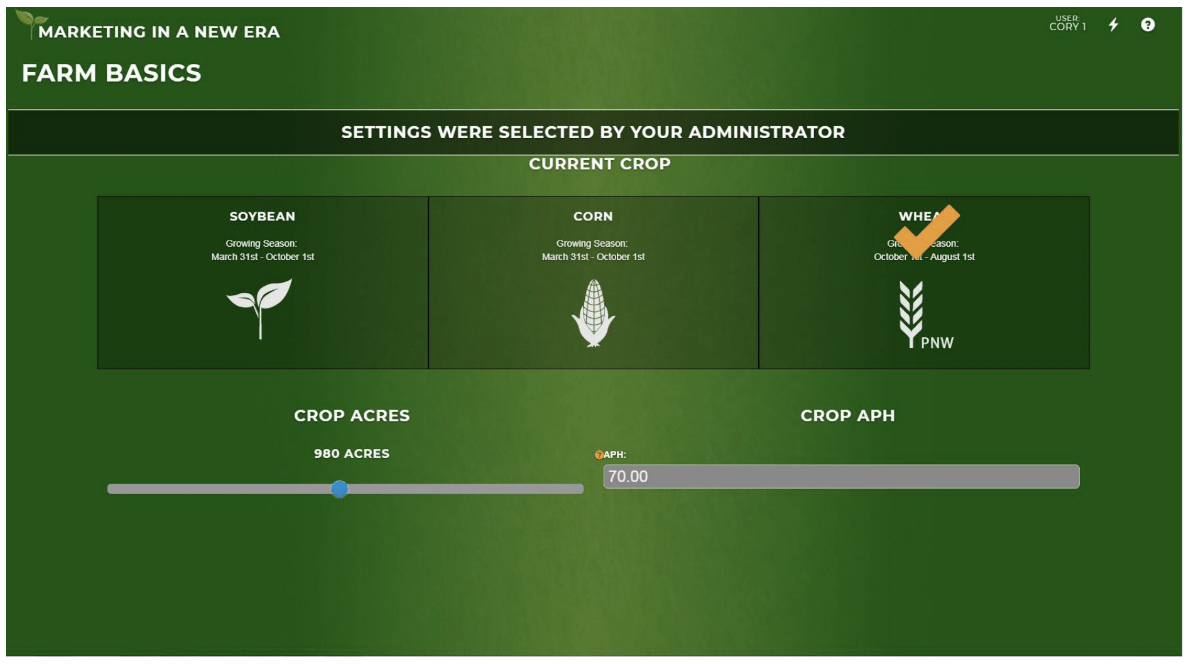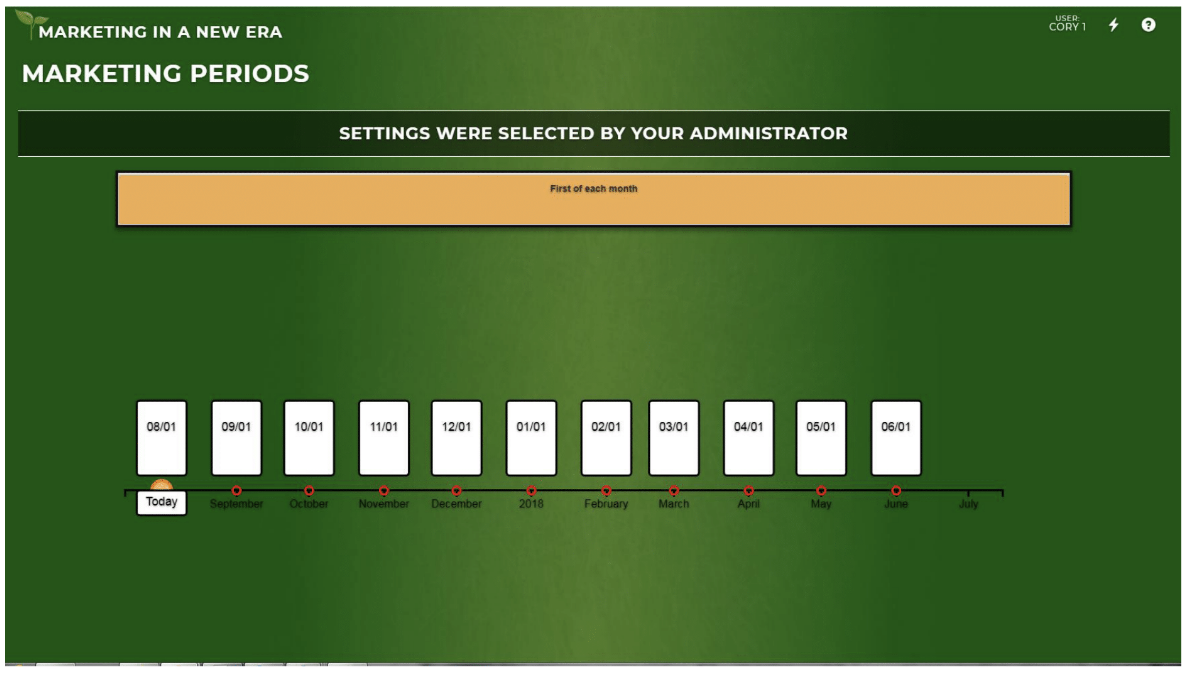 |
October 2018
|
October 2018 // Volume 56 // Number 6 // Tools of the Trade // v56-6tt4
A Unique Marketing Education Tool: The Marketing in a New Era Simulation Game
Abstract
This article describes a novel grain marketing simulation game called Marketing in a New Era (MINE) that was developed for use in Extension producer meetings and other educational settings. Key benefits of MINE are that users can personalize the game's marketing simulation environment by incorporating information specific to their operations or regions, users receive immediate feedback about their marketing simulation performance, and users can engage in numerous marketing simulations within a short time period.
Introduction
Each year grain producers face the threat of weak farm income, and possible farm failure, due to production risk and commodity price risk, meaning that room for mistakes is limited (Musser, Patrick, & Eckman, 1996). For producers, improving commodity price risk management by understanding how futures and options operate is essential to farm survival (Jones, 1993). However, in educational settings, it is challenging to make economic concepts interesting and rigorous enough for audiences to leave with an improved skill set. Advancements in educational technology have allowed for improvements in the interaction between Extension instructors and audiences by expanding experiential learning options. Simulation-based learning is one type of experiential learning that Extension educators can use to develop specific skills (Lean, Moizer, Towler, & Abbey, 2006).
Our team at the University of Nebraska developed an online grain marketing simulation game called Marketing in a New Era (MINE). MINE provides an interactive learning environment for grain marketing instruction and can be used in Extension producer meetings or in a variety of other educational settings. The uniqueness of MINE is that the participant can create an individualized realistic production scenario (i.e., one comprising realistic yields, costs, etc.) and then virtually experience the associated marketing environment, as determined by historical prices, by applying typical marketing tools (i.e., cash contracts, futures contracts, basis contracts, etc.). Participants are able to review results of their actions and ask questions during the educational session, and with MINE being accessible online, participants can keep improving their marketing skills after the educational session has ended. MINE allows producers to play multiple simulation games, each with a different price series, in a short period of time, resulting in a greatly enhanced learning experience. Furthermore, the ability of participants to use values similar to costs they experience on their own farms helps them conceptualize the game as an actual grain marketing environment.
MINE Simulation Game
In MINE, grain marketing is organized into two distinct periods: the preharvest period and the postharvest period. For the grain marketer, this is a logical organization because risks and important market variables differ across these two periods. Preharvest marketing allows for yield risk, whereas in the postharvest period, yield is known because the production cycle is complete. In the preharvest period, the marketer focuses on harvest price and basis, along with crop insurance; in the postharvest period, the focus is on price, futures carry, and basis.
When playing MINE, the producer can modify the following inputs: crop, crop acres, marketable bushels—expected yield (preharvest) or actual yield as indicated by bushels in storage (postharvest), current price, production cost (preharvest and postharvest) and storage cost (postharvest), crop insurance, and number of marketing periods.
- Crop. The user identifies the crop to be sold in the simulation (i.e., corn, soybeans, wheat) (see Figure 1). In a group setting, producers make a mutual decision on the preferable crop, and the instructor outlines the specific characteristics of that grain relative to the marketing process.
- Crop acres. The user determines the number of acres planted so that the plot size in the scenario resembles that on his or her farm or the average plot size in the local area.
- Marketable bushels. The user decides the number of bushels to be addressed. In the preharvest phase, users trade on the basis of an expected yield. In the postharvest period, the marketable bushels value is the number of bushels the producer has in storage available to market. The crop acres value interacts with the number of marketable bushels—the more acres there are, the more bushels there are to be traded.
- Current price. This variable is the current cash price for the grain.
- Production and storage costs. In simulations of both preharvest and postharvest marketing, the user faces a production cost that is fixed and can be similar to his or her actual production cost. With a postharvest marketing simulation, the user also incurs a storage cost.
- Crop insurance. This variable applies only in preharvest marketing scenarios. The user decides whether to use yield or revenue insurance. Together, total expected yield and crop insurance identify the per-acre guarantees.
- Marketing periods. The user selects the number of times he or she can make marketing decisions. The minimum is three periods, and the maximum is 12 (see Figure 2). Variation in number of marketing periods provides users with the flexibility to experience either fewer trade scenarios with many marketing periods or more scenarios with fewer marketing periods.
Figure 1.
Marketing in a New Era Crop Selection Screen

Figure 2.
Marketing in a New Era Marketing Periods Screen

One of the most important and innovative aspects of both preharvest and postharvest MINE simulations is the fact that the prices the participant faces are from previously experienced price series. The instructor selects a historical price series to create the price scenario for the simulation conducted by a producer. MINE includes charts that inform the instructor about price fluctuations across a time period. The instructor tacitly decides different price series for various simulations in order to demonstrate several market signals (e.g., futures carry). Because historical prices may not necessarily represent current prices, MINE provides the option to the instructor to adjust the historical prices to the current prices. Participants do not receive any information about the price series being used. Also contained in each historical price series is a harvest yield. The harvest yield represents growing conditions for that year.
In an educational setting, after the completion of a simulation, producers can explain how they made marketing decisions, and the instructor can lead a group discussion based on graphs that summarize producers' performances. The discussion allows producers to better understand which strategies worked best under specific conditions.
Conclusion
MINE represents an innovative educational tool suited to experiential learning opportunities offered by Extension educators. Educators can add MINE to traditional lecture-style presentations as a tool for reinforcing the crop marketing principles taught. By being able to engage users in numerous marketing simulations within a short time period and apply conditions specific to particular locations, educators can use MINE to help learners gain valuable real-world crop marketing experience. Learners can further their marketing education by accessing MINE online on their own and testing different strategies or tools. Extension educators interested in using MINE can obtain necessary credentials from us and access the tool at mine.unl.edu.
References
Jones, E. (1993). Trading clubs teach commodity marketing. Journal of Extension, 31(4), Article 4IAW5. Available at: https://www.joe.org/joe/1993winter/iw5.php
Lean, J., Moizer, J., Towler, M., & Abbey, C. (2006). Simulations and games: Use and barriers in higher education. Active Learning in Higher Education, 7(3), 227–242.
Musser, W. N., Patrick, G. F., & Eckman, D. T. (1996). Risk and grain marketing behavior of large-scale farmers. Review of Agricultural Economics, 65–77.



